Keef’s Total Noob’s (and old farts) Guide to Deriving
First lets start out with the boring legal definition of what a Derivative work is
A “derivative work” is a work based upon one or more pre-existing works, such as a translation, musical arrangement, dramatization, fictionalization, motion picture version, sound recording, art reproduction, abridgment, condensation, or any other form in which a work may be recast, transformed, or adapted. A work consisting of editorial revisions, annotations, elaborations, or other modifications which, as a whole, represent an original work of authorship, is a “derivative work”.
United States, the Copyright Act
However, in the world of IMVU the definition of a derivative work is much broader. Any product that reuses the assets, in whole or in part, of its parent product is considered a derivative work.
The difference… the legal meaning is a derivative borrows parts of the source but adds to it so it becomes something new, but in IMVU it doesn’t have to. Confused yet?
In IMVU if a product is made with deriving permission granted it means anyone can reuse any and/or all of its assets in their product. As the owner of the product is paid on every sale for this reuse, copyright does not apply. (deriving permission does not extend to the reuse of a creators logos and other marketing materials, just the product itself.)
Anyone can set their product to be used in this way, no matter how much or how little they have contributed to the product. Even products that are just repackaged and marked up carbon copies of the parent product can be set to be derived from.
This leads to all sorts of chaos and confusion for new content creators, faced with a sea of products all set to derivable how do you choose where to begin? Do you just pick a product you like and derive from it? Heck No!
In this guide I will take you though how deriving and product parentage works, and more importantly how to find the best, and CHEAPEST products to derive from and avoid getting ripped off.
What is a Deriving Chain?
Before you start submitting products you will need to get an understanding on how products on IMVU work.
All products (sans stickers) on IMVU follow a family tree structure, everything ultimately being a decendent of an IMVUinc ‘base’ or ‘root’ product and every product inherits the assets of its parents.
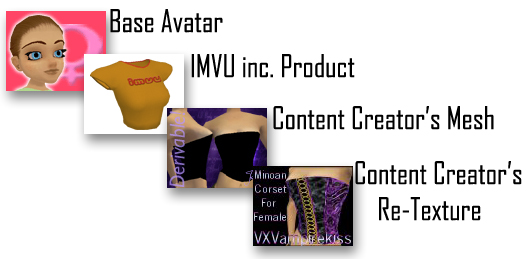
-In this example of a female garment it all starts with the IMVU base avatar. This is the bone structure all avatar products are built on. (rooms and furniture follow a different hierarchy.)
-Next is an IMVU base product, in this case the ‘Baby Yellow Tee’ that you met in IMVU’s beginning product making tutorial. This is used to tell the product it will be worn as a replacement body part.
-Next in line is the Content Creator’s mesh. This is a new 3D structure and new textures that were made by a 3D Content Creator.
-And lastly is the 2D Artist’s retexture of the new mesh, they are the ones who retexture the mesh into art.
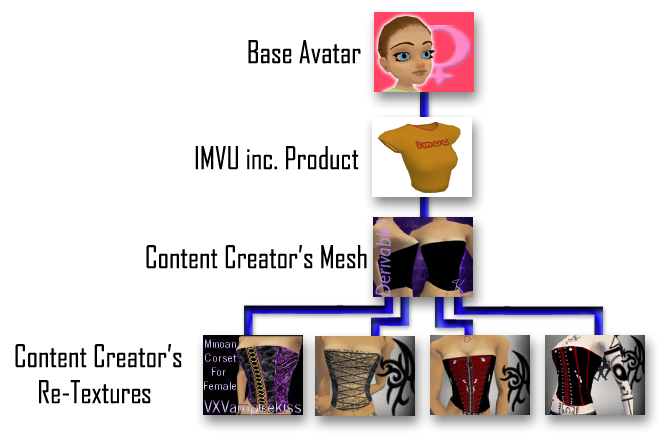
IMVU inc Base, New Mesh Product, Texture Artist Recolors.
Above is an example of how a deriving chain should look. A new mesh is Derived from an IMVUinc base product, that mesh is set to derivable and texture artists derive from that to make their recolors. Each retexture is linked to the original mesh product making for the shortest line possible to the root product.
But what happens when one of those recolors is set to derivable and is unknowingly derived from? And again? And Again?
Excessive Chain Deriving
When a product is derived it inherits all aspects of the parent products, including all the costs of those products along the way.
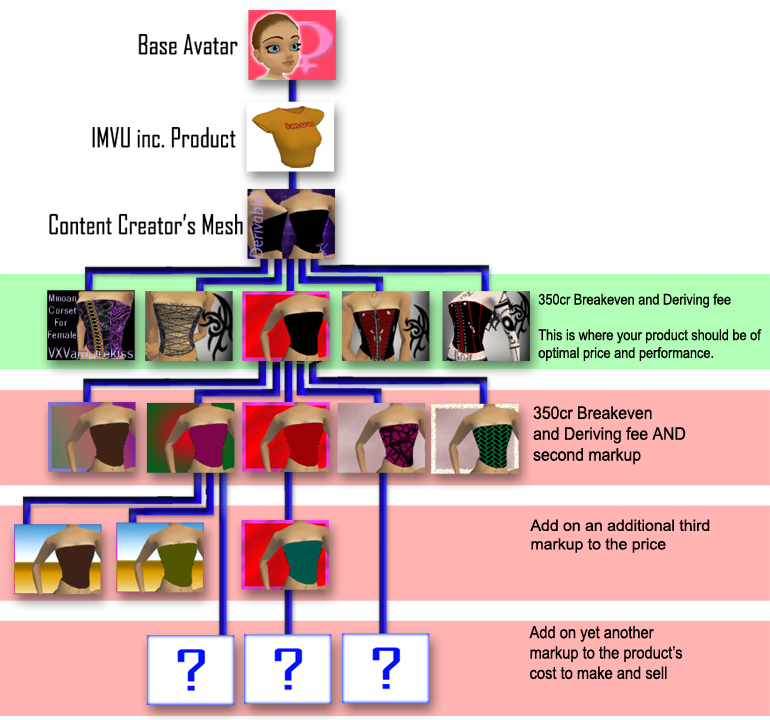
This one started out clean but the Content Creator with the red icon in the middle had set their item to derivable. In and of itself setting an item to derivable is not bad thing or against the rules. The problem arises when someone derives from it.
In the example above several other Content Creators have derived from that sub product (the first red zone). Each of those Content Creators has to pay and sell at an inflated price not only paying the original mesh fee but they are also are paying the Content Creator in the middle his full price.
Drop down another rung in the chain and another layer of fees and complexity is added on.
In real numbers, supposing each Content Creator along the way has marked up their product 100cr. That means if I don’t look at where I am deriving and my product ends up in one of the question mark slots my breakeven cost and deriving fee will be 550- 650 credits! This is for a mesh that should only cost you 350 credits!!!
It is ALWAYS best to keep this deriving tree as compact as possible. Long gangly tress make for grossly overpriced products.
What does this mean as a Content Creator?
At each new rung of the chain that product has most likely added on a fee, this could be anywhere from a few credits to thousands of credits. Those fees are not only needed to be paid at submission but are also paid each and every time the mesh is sold!
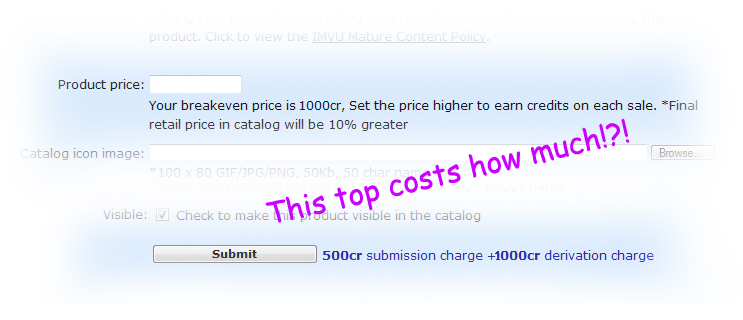
It is in the best interest of the Content Creator to seek out the oldest, and therefore lowest cost product in the chain to derive from for maximum profit potential.
It is impossible to price competitively and earn a profit if you chain derive of off a marked up child product.
Another thing to remember. The meshers product page ‘Derivations’ link as well as any mesher provided ‘Products made from this mesh’ link will only show direct child products. If you have not directly derived from the parent your product will not be in this search and you will miss out on this valuable marketing opportunity.
What does this mean for the consumer?
When a user loads a product in IMVU it will load all the products in that chain from parent to child before the final version loads. If a product has been derived several times this means several products have to download before the final item.
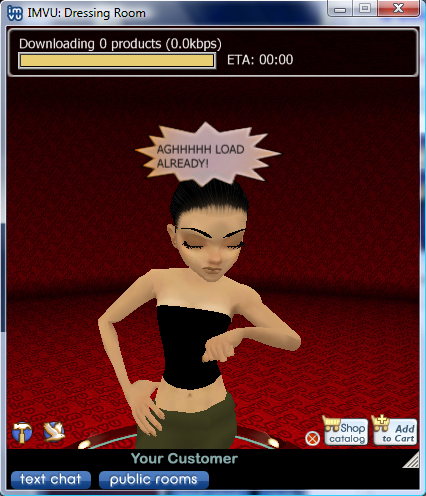
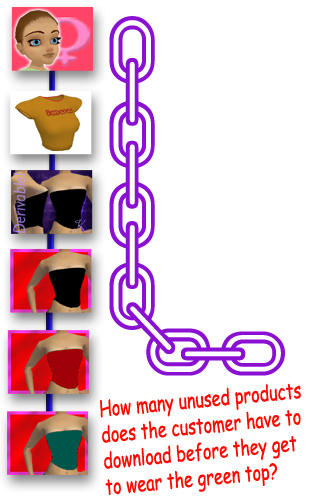
Needlessly chain derived products make for a more expensive catalog as there are many middle men all getting a cut. Higher prices means less items for your money. Would you rather buy two tops for the same price as one? So do your customers.
What does this mean as a Mesher?
Many mesh makers provide deriving information on the parent product, if a product is improperly chain derived that means the deriver has missed out on seeing this valuable information.
When a mesh is chain derived it becomes impossible for the mesh artist to track how a mesh is doing. While they will still see overall derived sales they cannot easily see the derived products themselves in order to see what the texture artist are doing with their products. If they cannot see what the texturers are doing it is impossible for them to gain an idea of where textures are wanting in further product making.
It also makes it impossible for a mesh maker to alert all those who have derived to any issues with the product.
How to Efficiently Derive.
When you find a derivable product you want to retexture you should always check to see if the one you found is at the base of the chain. To do this look under the product description on the right had side you should see a ‘Derived from’ and a link.
 A Product you found that you want to re texture.
A Product you found that you want to re texture.
-When you click on that link and it will take you to the parent of that product. Keep doing that until you get to an IMVUinc product.
 An IMVUinc base mesh that looks nothing like the mesh
An IMVUinc base mesh that looks nothing like the mesh
-If the IMVUinc product is the same mesh you are waiting to recolor that is the product you want to derive from.
-If the IMVUinc product is entirely different then hit the back button to get to the developer’s mesh and that is the product you want to derive from.
 Mesher’s Original Derivable mesh, the lowest cost option to use.
Mesher’s Original Derivable mesh, the lowest cost option to use.
There will be times when a product will link to a hidden product. In those cases you may want to ask the content creator, search around the catalog or ask in the texturing forums to see if that is truly the base product.
If the original source it is not available for you to use then you should then derive from the next available product in line from the hidden one. This is common when a mesher is working with a second content creator in a collaborative work.
Do note: there are some meshes on IMVU that are not available for deriving. It is the mesh maker’s prerogative whether to make their work derivable. If an item is not to be derived from that wish should be respected. Please do not harass mesh makers if they do not wish to release their work for the public to use, it is their work and their choice how to sell it.
When you should Chain Derive
Yes, there are times when chain deriving is the proper thing to do. If a second content creator has added a new asset to the product that you want to use and if you…
A: don’t want to or don’t have the skills to make the new asset(s) yourself.
B: don’t mind paying the second content creator a cut on every sale for use of the new asset(s).
New Assets of value include.
-A new or replaced mesh
-A new pose, animation or effect
-A complex opacity map or elaborate texture work.
Tiers and Derived Sales
Some folks are under the misconception that if they set their re-textured products to derivable they will be able to get some derived sales that will get them tier points in the all so elusive derived sales metric.
While on the surface that may seem like a good plan lets talk frankly about the numbers here. To compete in the derived sales metric you are going directly up against meshers and many meshers pull in BIG numbers, so even if you manage to get a few thousand derives it is not going to earn you any points. You are going to need tens of thousands of derived sales just to get a point, pretty much an impossibility to earn from random peeps deriving off you instead of the source mesh.
If your allowing derives to allow folks to re-use a texture or a map that’s fine, just do it for that reason, not for earning points so you wont be disappointed.
Now for the Ugly Side…
Zero Chage Derives
There is becoming a more and more common practice by some to derive off of a derivable product submit it as-is and sell it (somtimes even going so far as to be so bold as to steal the original creators icons). Theses products are commonly refereed to as ‘zero change derives’. They’re easy to spot, if you go to the product page of the item just look to the KB weight that has been added to the product, if its zero they haven’t added a dang thing. When looking for a new mesh or even shopping for something to buy these products should be avoided. Just click past them by using the derived from link to get to the parent.
If you want to get into derivable business you must clearly understand that when you set an item to be derivable, no matter what you may nicely ask to happen on your product page, you are granting express permission for these zero change derives to be made. If you are uncomfortable with seeing your product in whole or in part being sold with another devs name on it then NEVER set it to derivable.
That all said there are times when a zero change drive can be a good thing, some meshers and animators even cater to it as repackaging a product in a whole new and imaginative way is a great way for it to be seen by a broader consumer base. Unfortunately this type of creative repackaging is not the norm.
Stolen Marketing
While the deriving chain allows one to reuse a product without changing a thing it does not grant rights to use any of the Content Creators marketing materials including, icons, product page images, videos and product descriptions. Unless the Creator has granted express permission that an image or video can be reused in a child products marking it is against TOS to do so and DMCA take-downs can be filed.
Broken Deriving Chains
A broken deriving chain occurs when a mesh and/or its textures are reused by another but by using a hack they circumvent the parenting chain to cut the creators who made the asset(s) out of the loop. This is asset theft and is expressly against the TOS. Any produt you find that looks to have been hacked or cracked in this way should be repoeted to the original creator so they can take proper legal action.
In Conclusion
Bottom line, deriving from the wrong product costs you and your customer’s needless extra money.
Derivability is a useful tool when used properly, but it can also be greatly abused and many a new developer who does not understand the process gets trapped into having overpriced products.
Chain Deriving is a common ethical debate in the IMVU Content Creator community. Is it ethical to leave re-textures derivable so that this mis derviving can even happen? Only you as an individual can decide what deriving practice is best of you.
There are indeed valid reasons to leave a retexture derivable. The problem has always been not that the item is left derivable, it is that it is derived from by those who do not understand who and what they are paying for.
Being educated on the deriving process will greatly lessen your frustrations in developing.
Happy Deriving!



